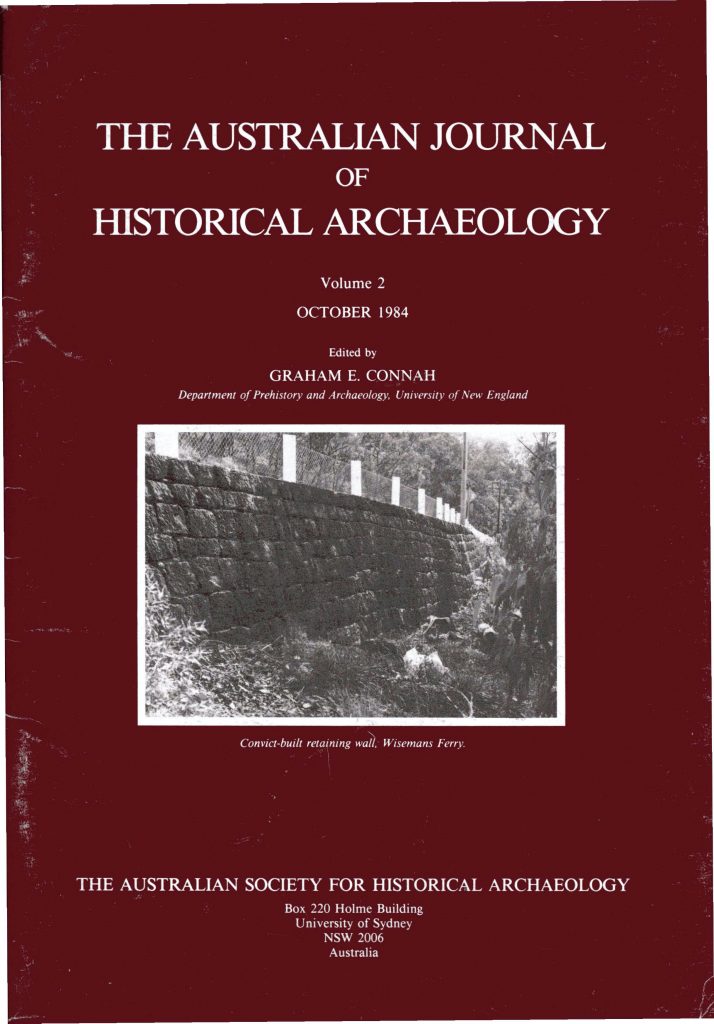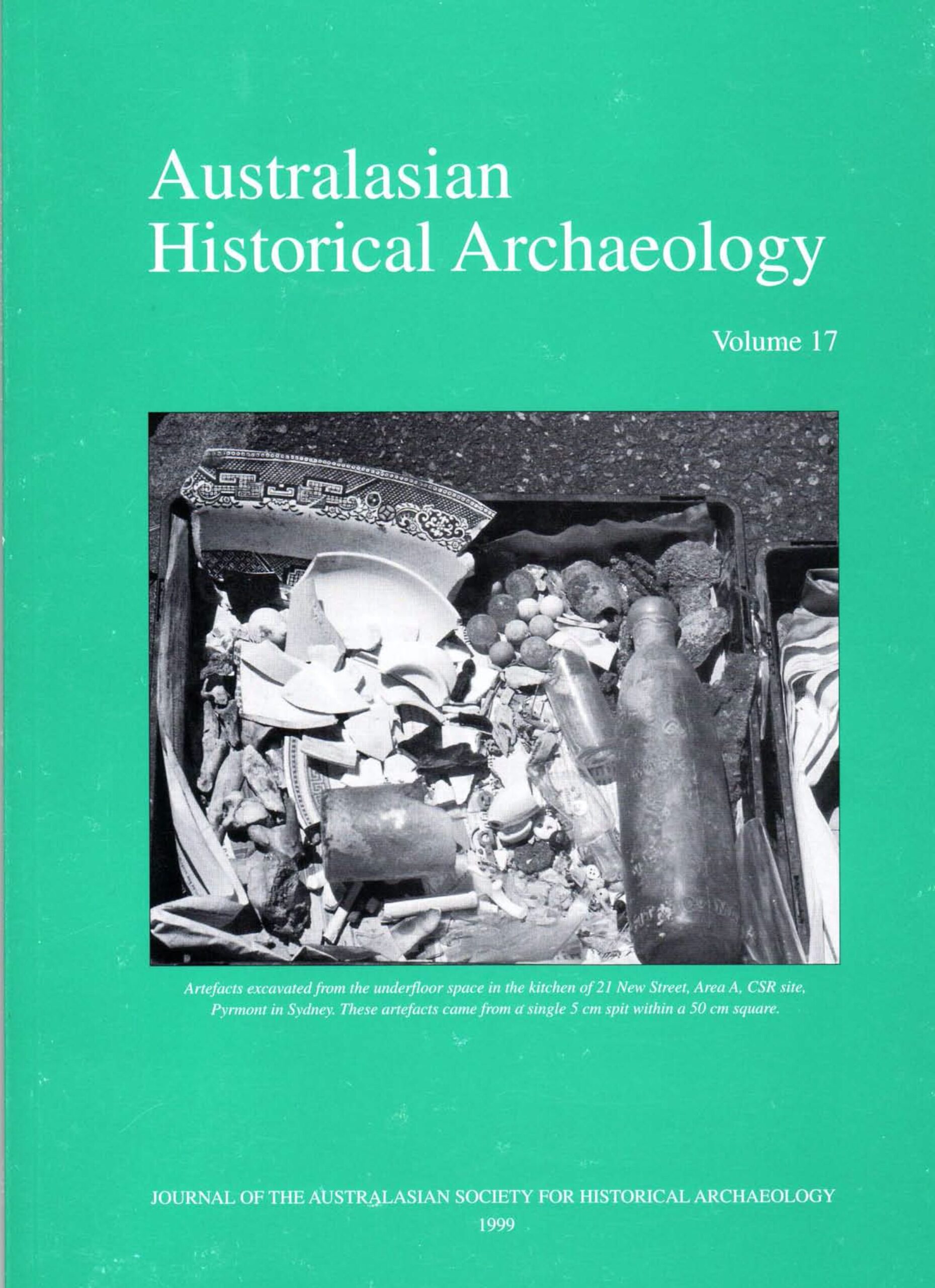Australasian Historical Archaeology is published annually in December and accepts original articles relevant to the research and practice of Historical Archaeology in Australasia and the wider region. Contributions from other regions will also be considered by the Editor/s. Submissions are accepted in the following categories:
- Articles 5,000–6,000 words (excluding references) and 6–8 figures/tables
- Research reports 1,500–3,000 words (excluding references) and 4–5 figures/tables
- Thesis abstracts 300–350 words for PhD and 150–200 words for Masters and Honours.
Longer submissions, and additional figures, may be accepted at the discretion of the Editor/s.
Submission
Contributions should be submitted via email to [email protected] as a Word file (.doc or .docx).
Manuscripts must be typed in 12-point font, double-line spaced with wide margins and page numbers. Authors are encouraged to use this Manuscript Submission Template.
The manuscript should include: 1) a cover page with the author/s contact information (including address, phone and email), current affiliation and a 50-word biographical statement; 2) an Abstract (no more than 150 words); 3) 3–5 Keywords; 4) a list of References (see below for specifications); and 5) a list of captions for illustrations. Acknowledgements (if included) should precede References. Do not use more than three levels of headings and do not use footnotes. Remove codes created by referencing software e.g. EndNote, RefWorks.
Illustrations should be provided as separate files (see below for specifications). Historical artwork or photographs should be appropriately cited.
Submissions that do not follow these requirements will be returned to the authors.

Editorial Process
Papers submitted to the Editor/s will be sent to two independent and anonymous referees for review. Research reports will be sent to at least one, and usually two, referees. The author’s name and affiliation will be revealed to the referee unless the author requests anonymity. Each referee will be asked to provide comments on the scholarly quality of the content of the paper and on its suitability for publication in AHA. If necessary, they will be asked to recommend revisions required to make the paper acceptable for publication. The Editor/s will then forward these comments to the author.
Once the author has addressed these comments, they will submit an electronic version of the final. This will be reviewed by the Editor/s for stylistic consistency before the copy is type-set.
Authors will receive page proofs of their articles as a PDF and are asked to return the corrected proofs promptly. No substantive changes can be made at that time.
In lieu of offprints, authors will receive one free copy of the volume in which their paper appears (limit one per article) and a final PDF copy of the published work.
The journal follows a code of conduct that governs the responsibilities of both the editors and authors.

Style Guide
AHA follows the Australian government Style Manual (6th ed.). Please note the following:
- British spelling is to be used throughout: ‘colonisation’ not ‘colonization’
- Hyphenate compound adjectives ‘gold-mining settlement’ and ‘19th-century ceramics’
- Use numerals (no superscript) for century: ‘19th century’ not ‘nineteenth century’
- Numbers over 10,000 with commas
- Numbers up to ten spelt out e.g. ‘two’; 11 and above given as numerals
- Numbers with decimal places given as numerals to one decimal place
- Per cent spelt in-text; % used in tables
- Date ranges: ‘1865–1866’ not ‘1865–66’ or ‘1865–6’
- Circa: ‘c. 1860’ not ‘c.1860’ or ‘c 1860’
- Measurements should be given in metric unless from primary source where the metric conversion should follow in brackets e.g. ‘three feet (0.9 m)’.
- Metric units abbreviated without full stop e.g. ‘0.9 m’ not ‘0.9 m.’ or ‘nine metres’. Imperial measurements can follow in brackets e.g. ‘0.9 m (three feet)’.
- Indent quotations of three or more lines and precede with colon.
- Use single quotation marks for quotes and double quotation marks within e.g. ‘Smith’s recollection of the “coup” was tainted with hindsight’.
In-text Citations
Referencing is to follow the Harvard style. Author’s surname, publication year and page(s) (e.g. Arnold 1992:159–161). For three or more authors et al. should be used after the first surname (e.g. Lovejoy et al. 1985:16). Multiple references should be separated by semicolon, or in the case of multiple references to the same author(s), by a comma (e.g. Casey 1999, 2010; Casey and Winnett 2010:344; Fahy 1967:42; Kelloway et al. 2010:88). For newspapers, if the author is unknown, include name of paper, date and page (e.g. Moreton Bay Courier 24 Jan. 1862:4). For personal communication, include the name and date (e.g. D. Smith pers. comm. 1 Jan. 2000).
References
References should be on a separate page and include all and only those references cited in the manuscript. Download the full Style Guide for further details.
Illustrations
All illustrations should be submitted in electronic form only. A list of captions for figures and tables must be provided at the end of the manuscript. Each caption must indicate the creator, date, copyright holder and/or source reference in brackets, e.g. ‘(Photography by T. Smith, 1 June 2015)’ or ‘(Courtesy of the National Library of Australia, NLA267X)’. Maps must identify the creator or copyright holder of the base map, e.g. (Prepared by S. Jones after © Historical Maps Online, Plan 621).
It is the author’s responsibility to obtain permission to reproduce images.
Photographs
Photographs can be reproduced in AHA in either colour or greyscale. Images should be submitted in .jpg or .tif format with a minimum resolution of 300 dpi. Other common formats may be accepted at the discretion of the Editor/s.
Line drawings
All line drawings, maps and diagrams must be prepared with a resolution of at least 600 dpi or in an appropriate vector format (e.g. .ai or .eps).
Ensure maps include a linear scale and north arrow.
Charts
Charts can be reproduced in AHA in either colour or greyscale. They may be supplied as per guidance for Line drawings, or a spreadsheet with embedded data.
Tables
Tables should be in the format shown in the Style Guide. Use black and white formatting, not colour. Note that the table will be stretched across the column or page.
Each table should be on a separate page.
Copyright
Copy is accepted for publication on the understanding that it has not been published elsewhere, and that it will not be, without the permission of the Editor/s.
Authors assign copyright of their paper to ASHA. ASHA retains the right to publish, adapt or modify material in the paper for use in conjunction with computer systems, including networks. Papers may be published in printed or digital form, online or other machine-readable form.
Authors may apply to the Editor/s for permission to reproduce their paper elsewhere, provided that due acknowledgement is made in any further publication that the work was originally published in AHA.
ASHA does not retain copyright for manuscripts that it does not publish.
Authors are responsible for obtaining permission to reproduce copyright-protected illustrations in their paper.

Download
Prospective authors should refer to the AHA Style Guide, which can be downloaded here.
A Manuscript Submission Template is available for authors. This includes all essential information needed to process your submission.
Contacts
For more information contact the Editorial Panel:
Eleanor Casella, Andrew Wilson, Matthew Kelly and Denis Gojak
[email protected]

